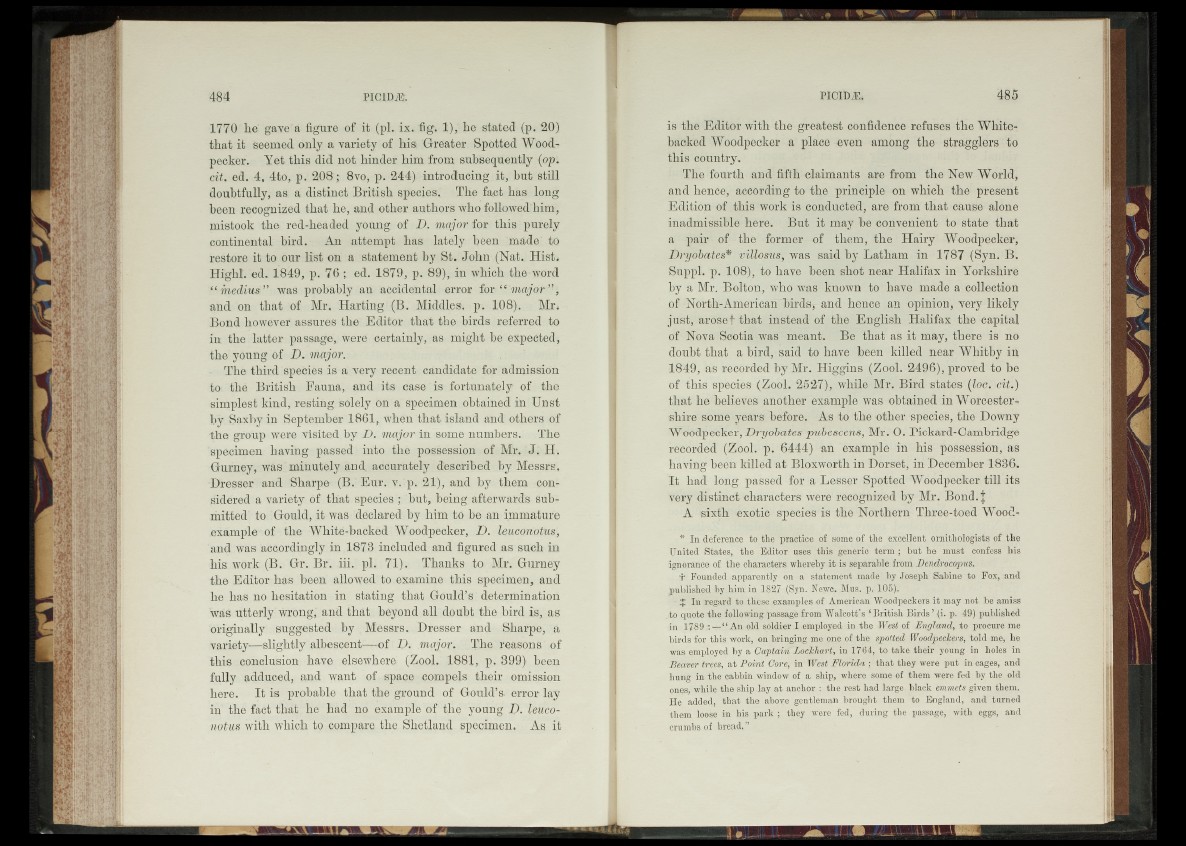
1770 he gave a figure of it (pi. ix. fig. 1), he stated (p. 20)
that it seemed only a variety of his Greater Spotted Woodpecker.
Yet this did not hinder him from subsequently (op.
cit. ed. 4, 4to, p. 208; 8vo, p. 244) introducing it, but still
doubtfully, as a distinct British species. The fact has long
been recognized that he, and other authors who followed him,
mistook the red-headed young of D. major for this purely
continental bird. An attempt has lately been made to
restore it to our list on a statement by St. John (Nat., Hist,
Highl. ed. 1849, p. 76 ; ed. 1879, p. 89), in which the word
“ medius” was probably an accidental error for “ major”,
and on that of Mr, Harting (B. Middles, p. 108). Mr,
Bond however assures the Editor that the birds referred to
in the latter passage, were certainly, as might be expected,
the young of D. major.
The third species is a very recent candidate for admission
to the British Fauna, and its case is fortunately of the
simplest kind, resting solely on a specimen obtained in Unst
by Saxby in September 1861, when that island and others of
the. group were visited by D. major in some numbers. The
specimen having passed into the possession of Mr. J. H.
Gurney, was minutely and accurately described by Messrs,
Dresser and Sharpe (B. Eur. v. p. 21), and by them considered
a variety of that species ; but, being afterwards submitted
to Gould, it was declared by him to be an immature
example of the White-backed Woodpecker, I). leuconotus,
and was accordingly in 1878 included and figured as such in
his work (B. Gr. Br. iii. pi. 71). Thanks to Mr. Gurney
the Editor has been allowed to examine this specimen, and
he has no hesitation in stating that Gould’s determination
was utterly wrong, and that beyond all doubt the bird is, as
originally suggested by Messrs. Dresser and Sharpe, a
variety—slightly albescent—of JO. major. The reasons of
this conclusion have elsewhere (Zool. 1881, p. 899) been
fully adduced, and want of space compels their omission
here. It is probable that the ground of Gould’s- error lay
in the fact that he had no example of the young D. leuconotus
with which to compare the Shetland specimen. As it
is the Editor with the greatest confidence refuses the White-
backed Woodpecker a place even among the stragglers to
this country.
The fourth and fifth claimants are from the New World,
and hence, according to the principle on which the present
Edition of this work is conducted, are from that cause alone
inadmissible here. But it may be convenient to state that
a pair of the former of them, the Hairy Woodpecker,
Dryobates* villosus, was said by Latham in 1787 (Syn. B.
Suppl. p. 108), to have been shot near Halifax in Yorkshire
by a Mr. Bolton, who wras known to have made a collection
of North-American birds-, and hence an opinion, very likely
just, arosef that instead of the English Halifax the capital
of Nova Scotia was meant. Be that as it may, there is no
doubt that a bird, said to have been killed near Whitby in
1849, as recorded by Mr. Higgins (Zool. 2496), proved to be
of this species (Zool. 2527), while Mr. Bird states (loc. cit.)
that he believes another example was obtained in Worcestershire
some years before. As to the other species, the Downy
Woodpecker, Dryobates pubescens, Mr. O. Pickard-Cambridge
recorded (Zool. p. 6444) an example in his possession, as
having been killed at Bloxworth in Dorset, in December 1836.
It had long passed for a Lesser Spotted Woodpecker till its
very distinct characters were recognized by Mr. Bond, j
A sixth exotic species is the Northern Three-toed Wood-
* In deference to the practice of some of the excellent ornithologists of the
United States, the Editor uses this generic term ; but he must confess his
ignorance of the characters whereby it is separable from Denclroeopus.
h Founded apparently on a statement made by Joseph Sabine to Fox, and
published by him in 1827 (Syn. Newc. Mus. p. 105).
X In regard to these examples of American Woodpeckers it may not he amiss
to quote the following passage from Walcott's ‘ British Birds ’ (i. p. 49) published
in 1789.:—“ An old soldier I employed in the West of England, to procure me
birds for this work, on bringing me one of the spotted Woodpeckers, told me, he
was employed by a Captain Loclchart, in 1764, to take their young in holes in
Beaver trees, at Point Core, in West Florida ; that they were put in cages, and
hung in the cabbin window of a ship, where some of them were fed by the old
ones, while the ship lay at anchor : the rest had large black emmets given them.
He added, that the above gentleman brought them to England, and turned
them loose in his park ; they were fed, during the passage, with eggs, and
crumbs of bread.”